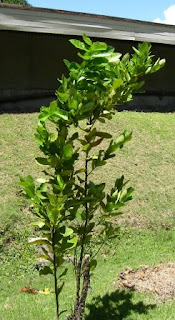 and batuan. I will continue to search for more specific information. So far, biasong seems to be a citrus fruit, leaves quite distinct from limes and lemons I am familiar with, leaves with a quite distinctive flavor: I was certain these were the leaves used in kinilaw. However, Diding suggested it would be the fruit, apparently a small citrus. I mentioned suha?, and she suggested this is somewhat larger. Batuan fruits are also used in sinigang.
and batuan. I will continue to search for more specific information. So far, biasong seems to be a citrus fruit, leaves quite distinct from limes and lemons I am familiar with, leaves with a quite distinctive flavor: I was certain these were the leaves used in kinilaw. However, Diding suggested it would be the fruit, apparently a small citrus. I mentioned suha?, and she suggested this is somewhat larger. Batuan fruits are also used in sinigang.There ensued a short discussion of sinigang, as I mentioned that I was unsatisfied by the sinigang at Aling Cora. She stated that sinigang is actually a Luzon dish, that visayans do not eat or did not eat much sinigang, but tinola was more the dish, spicy and salty. I spied in Jose Rizal's Noli mi tangere a description of the cooking of a sinigang with bilimbi, I think, which was pointed out elsewhere as the pickle tree, a very sour fruit related to the carambola (star fruit) and reported elsewhere as being boiled with sugar into a lemonade like concoction. Diding says this may be iba?, also used in sinigang.
Mangos
Mangos have been a joy, in Luzon, all over. Here, the mangos are distinct from the hawaiian mango (such as the hayden) or the mangoes eaten in micronesia, usually green. The mangoes here are a clear custard yellow color, without any blush of red, and are of a different texture than those I know in Hawaii or the ripe mangoes in Micronesia. They are creamy and delicious. Fantastic.
I found a description of mangoes in a book on Malaysian fruits. Not only varieties, be several species, are mentioned. A number of these are mentioned as poisonous if unripe. Fe's father, Crisostomo Sabuero, and her sister Virgie, know of a fruit, mango-like, known as both pangngi and pangnga (spelling?). It is similar in size to a "mango carabao", and has perforations or spots in the skin, and is poisonous to eat if unripe. Virgie says that even if it is ripe, it is unwise to eat very many, as there is still some poison in them. She said the farm of her husband had a tree, that bears a few fruits in it's proper time.
As far as mango seasons, I learned from Professor Muniappan of the U of Guam some years ago that mangoes are not seasonal, but bear opportunistically. Once the tree drops its leaves, it takes about four months to come into ripe fruits. I had been trying to link El Nino to seasonality of various plants in Chuuk, Micronesia. Mangoes will drop fruit or flowers when it rains much, so in prolonged dry spells, more than one fruit cycle per year may result. In Chuuk, three cycles are found in a "good" year. Prof. Muniappan said that Indian mango producers spray defoliants on the orchards once fruit has been harvested, to initiate the fruit cycle immediately. Philippinos apparently know this. It is quite striking to one who has lived in the "tiny islands" for over 20 years to drive past a mango orchard such as those I saw in La Union.
I am unable to upload photos in this Internet cafe. This place has lousy keyboards: I asked for a good one, and got one with a very crummy, slow kb. Most of the Internet Cafes I have visited in the PI are using older versions of IE, without tabs, and no firefox. I have yet to stumble across Linux yet, but have found some interest. One problematical issue to look out for: operators seem, when asked to print a file (including a bank statement) to copy and paste the page to M$ writer, and print the file from there. The result, whatever their reasoning, is a copy of your file on the machine. I had to dog one admin until he deleted the files. It ought not be a problem to set up printing directly from Firefox or IE, for that matter, without the need for this step. I also required intervention by the sysop, which is a PITA. This needs to be brought to the attention of the PLUG.
No comments:
Post a Comment